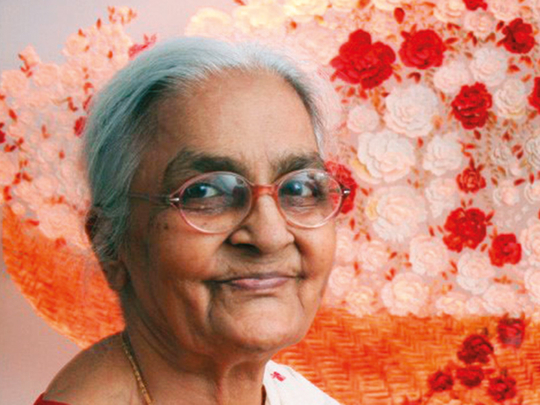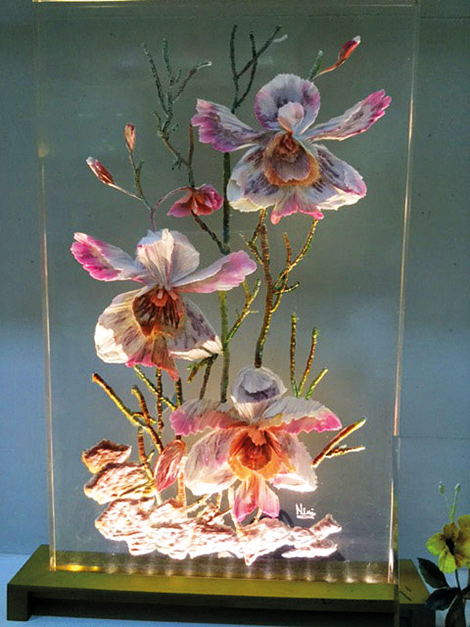
Mumbai: At 91, Nalini Vinay Mehta hasn’t let go of her zeal for acrylic carving, a unique art that she has excelled in for the last 70 years and is perhaps the only accomplished artist in this field in India and around the globe.
The Indian government recognised her work with a National Award for Creative Art in October 2013, an award given for the first time to senior citizens for their achievements. Yet this exclusive and exquisite art may not have a future taking into account that it requires an amalgam of artistic talent, the ability to have 3-D visualisation of the outcome, technical skills to handle an electric drill and loads and loads of patience.
The disappointment is certainly there since this demanding and gorgeous art hasn’t taken wings with the younger generation but, “I don’t feel bad,” Mehta told Gulf News, speaking at her residence here. And with a twinkle in her eye, she said, “Now I only want to meet Modiji (Prime Minister Narendra Modi) and show him my work. That’s my only wish.”
Her youngest son Anuj adds, “The Prime Minister should know that there is a woman in this country who continues to create something so distinctive and beautiful.” Anuj has taken upon himself to ensure that this art is somehow carried into the future through a newer breed of committed artists willing to take up the challenge of internal acrylic carving. More importantly, he wants to install his mum’s works in a place where everyone can see and enjoy this art.
Meanwhile, Mehta smiles away her son’s anxiety and continues to remain passionate about her art. A recent bout of flu and cough hasn’t sapped her energy and she walks slowly with the help of a walker into her studio to show this correspondent the objets d’arts that she has so lovingly etched in the last many years. It’s a sight to behold and every piece of her carving will take anyone’s breath away.
There are rows of intricately carved and coloured sheet acrylic, with edge lighting to give an ethereal effect. Mehta’s affinity with nature, specifically flowers, is obvious. “I had carved tube roses but was unsure about the stems and had to wait for six months until someone brought the flowers and I could complete it. This was 10 years back.
“Recently, I’ve done so much. I have yet to colour them,” she says as she looks around the studio. Wasting no time, this nonagenarian sets out to work on an acrylic sheet with a high speed 35,000 rpm electric drill to notch out a floral design. “This bit is not working properly,” she tells her son who fixes another one.
Acrylic carving is an art extraordinaire, she explains. With no sketches or drawing to begin with, the artist has to visualise an image that is transfered on to a ½ inch or 11/2 inch thick sheet, using a drill to carve on the reverse of the sheet, not too deep lest it comes out on the other side. “Like a surgeon who cannot make mistakes, I, too, have to be extremely careful,” says Mehta. “The feel for colours comes from your subconscious mind.
“I did not learn but developed it after a chance encounter in New York way back in 1946,” she says.
The newlywed was accompanying her husband who was on his way to complete his postgraduate studies in chemical engineering in the US. Though she herself is an MA in Economics, she loved painting, sculpture and batik and therefore joined the Pratt Institute for Commercial Art. “There was nothing new I could learn there and left the course in six months. And just a month before we left the US, a colleague from the Institute and I chanced upon this unusual art. It fired my imagination and after my return I carved my first piece with three roses on a piece of acrylic and coloured it by dropping dyes with an eye dropper. My husband thought it was wonderful and other family members loved the new art, going gaga over it. Nobody had ever seen anything like this.”
Her initial source of material was from acrylic bangle makers from whom she bought the left over circular cutout pieces for Rs4 a kilo.
“My husband was excited about this art and would scout the city to find the material. He always encouraged me.” Unfortunately, she had to leave aside this pursuit when her husband suddenly died in 1970 and she had to run his chemical engineering factory. “It was another challenge before me as I wanted to give the best education to my three sons and daughter. I’m proud that two are architects, one a doctor and another a chemical engineer.”
Twelve years later, she restarted this art, went commercial, taught free for 10 years but now her family only wants to preserve whatever she creates — out of the 500 pieces made by her, they are left with a collection of 150.












